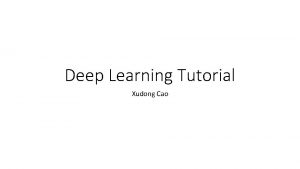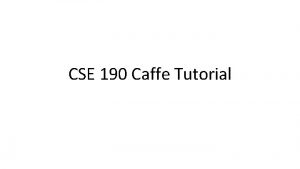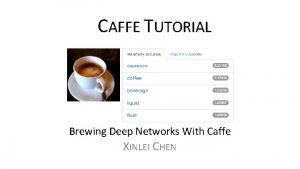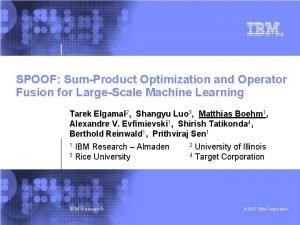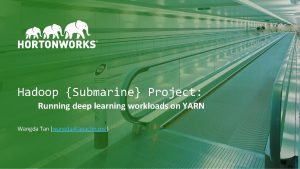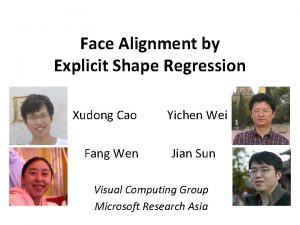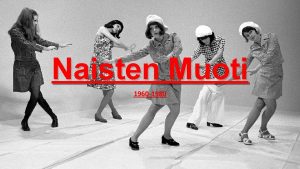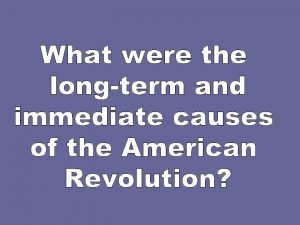Deep Learning Tutorial Xudong Cao Historical Line 1960















- Slides: 15

Deep Learning Tutorial Xudong Cao

Historical Line 1960 s Perceptron 1980 s MLP BP algorithm Rule based AI algorithm Game Tree & Search Algorithm 2006 RBM unsupervised learning Support vector machine 2012 Alex. Net Image. Net Comp. Wrong direction 2014 Google. Net VGGNet Image. Net Comp. Big booming: • DNNResearch 6 M, Deep. Mind 400 M • Google, Microsoft, Baidu, FB, Apple • Hundreds of Startups

Linear inseparable problem & fitting power

Solution 1: Going High dimension Implicitly project to high dim. Explicitly design high-dim. features e. g. high-dim LBP and fisher vector

Solution 2: Going Deep

High-Dim VS. Deep High-Dim • Easy to train, convex in general • Solid mathematic foundation • Generalized well • Low computational cost Deep • Hard to train, non-convex • Black magic & unknown territory • Prone to over-fitting • High computational cost • Fitting power scales linearly • Fitting power scales exponentially

Explains why people hated neural networks in the past, BUT time changes …

New Era: Big Data & Moore’s Rule

Practical application Xiaogang Wang, Introduction to Deep Learning

End-to-end learning, less domain knowledge Conventional Approach Training Model Design Networks Design Feature Design Deep Learning Pre-processing Collect Data No or very small amount of domain knowledge Small amount of domain knowledge Large amount of domain knowledge Collect Data

Good features Xiaogang Wang, Introduction to Deep Learning

Good features cont. Transfer Image. Net features to other tasks Dataset Conv. Best (acc) Tran. Best (acc) Oxford 102 Flowers 91. 3% 98. 7% Oxford-IIIT Pets 88. 1% 93. 1% FGVC-Aircraft 81. 5% 85. 2% MIT-67 indoor 49 68. 9% 82. 4% Transfer the face identification features to age estimation & gender classification Human Age Estimation Dataset Pre. Best (MAE) Ours(MAE) Morph 3. 6 2. 4 FGNet 3. 2 Geneder Classification 2. 7 Dataset Pre. Best (acc) Ours(acc) Morph 98. 7% 99. 4%

Directions of DL Research • Feature engineering to architecture engineering • Image. Net Classification with Deep Convolutional Neural Networks (Alex Net) • Going Deeper with Convolutions (Google Net) • Very Deep Convolutional Networks for Large-Scale Visual Recognition (VGG Net) • Faster and smaller • How to train very deep neural network • Batch Normalization: Accelerating Deep Network Training by Reducing Internal Covariate Shift (Speedup CNN training) • Delving Deep into Rectifiers: Surpassing Human-Level Performance on Image. Net Classification (Good initialization)

Directions of DL Research cont. • Existing Applications • Face: Deep. Face, Deep ID serials & Face. Net • Detection: R-CNN, faster R-CNN • Segmentation: F-CNN serials • New applications • Image captioning [Google & Berkeley] • Synthesize real world images [Facebook AI Lab] • A Neural Algorithm of Artistic Style [Gatys et al. ]

 Xudong cao
Xudong cao This color symbolizes fierceness and roughness
This color symbolizes fierceness and roughness Caffe framework tutorial
Caffe framework tutorial Caffe deep learning tutorial
Caffe deep learning tutorial Cmu machine learning
Cmu machine learning Tony wagner's seven survival skills
Tony wagner's seven survival skills Deep asleep deep asleep it lies
Deep asleep deep asleep it lies Deep forest: towards an alternative to deep neural networks
Deep forest: towards an alternative to deep neural networks 深哉深哉耶穌的愛
深哉深哉耶穌的愛 A plain scale of 1 cm=5m and show on it 37m
A plain scale of 1 cm=5m and show on it 37m Cuadro comparativo e-learning b-learning m-learning
Cuadro comparativo e-learning b-learning m-learning Superficial front line
Superficial front line Deep front line fascia
Deep front line fascia Operator fusion deep learning
Operator fusion deep learning Rnn
Rnn Hortonworks gpu
Hortonworks gpu
